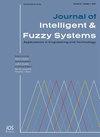Bi-channel hybrid GAN attention based anomaly detection system for multi-domain SDN environment
IF 1
4区 计算机科学
Q3 COMPUTER SCIENCE, ARTIFICIAL INTELLIGENCE
引用次数: 0
Abstract
Software-Defined Networking (SDN) is a strategy that leads the network via software by separating its control plane from the underlying forwarding plane. In support of a global digital network, multi-domain SDN architecture emerges as a viable solution. However, the complex and ever-evolving nature of network threats in a multi-domain environment presents a significant security challenge for controllers in detecting abnormalities. Moreover, multi-domain anomaly detection poses a daunting problem due to the need to process vast amounts of data from diverse domains. Deep learning models have gained popularity for extracting high-level feature representations from massive datasets. In this work, a novel deep neural network architecture, supervised learning based LD-BiHGA (Low Dimensional Bi-channel Hybrid GAN Attention) system is designed to learn class-specific features for accurate anomaly detection. Two asymmetric GANs are employed for learning the normal and abnormal network flows separately. Then, to extract more relevant features, a bi-channel attention mechanism is added. This is the first study to introduce an innovative hybrid architecture that merges bi-channel hybrid GANs with attention models for the purpose of anomaly detection in a multi-domain SDN environment that effectively handles real-time unbalanced data. The suggested architecture demonstrates its effectiveness on three benchmark datasets, achieving an average accuracy improvement of 7.225% on balanced datasets and 3.335% on imbalanced datasets compared to previous intrusion detection system (IDS) architectures in the literature.多域SDN环境下基于双通道混合GAN关注的异常检测系统
软件定义网络(SDN)是一种通过软件引导网络的策略,它将网络的控制平面与底层转发平面分离开来。为了支持全球数字网络,多域SDN架构成为一种可行的解决方案。然而,在多域环境下,网络威胁的复杂性和不断发展的特性对控制器检测异常提出了重大的安全挑战。此外,由于需要处理来自不同领域的大量数据,多领域异常检测是一个令人望而生畏的问题。深度学习模型在从大量数据集中提取高级特征表示方面已经获得了普及。在这项工作中,设计了一种新的深度神经网络架构,基于监督学习的LD-BiHGA(低维双通道混合GAN注意)系统,用于学习特定类别的特征,以实现准确的异常检测。采用两个非对称gan分别学习正常和异常网络流。然后,为了提取更多的相关特征,增加了双通道注意机制。这是第一个引入创新混合架构的研究,该架构将双通道混合gan与注意力模型合并,用于在多域SDN环境中有效处理实时不平衡数据的异常检测。该架构在三个基准数据集上证明了其有效性,与文献中先前的入侵检测系统(IDS)架构相比,平衡数据集的平均准确率提高了7.225%,不平衡数据集的平均准确率提高了3.335%。
本文章由计算机程序翻译,如有差异,请以英文原文为准。
求助全文
约1分钟内获得全文
求助全文
来源期刊

Journal of Intelligent & Fuzzy Systems
工程技术-计算机:人工智能
CiteScore
3.40
自引率
10.00%
发文量
965
审稿时长
5.1 months
期刊介绍:
The purpose of the Journal of Intelligent & Fuzzy Systems: Applications in Engineering and Technology is to foster advancements of knowledge and help disseminate results concerning recent applications and case studies in the areas of fuzzy logic, intelligent systems, and web-based applications among working professionals and professionals in education and research, covering a broad cross-section of technical disciplines.
 求助内容:
求助内容: 应助结果提醒方式:
应助结果提醒方式:


